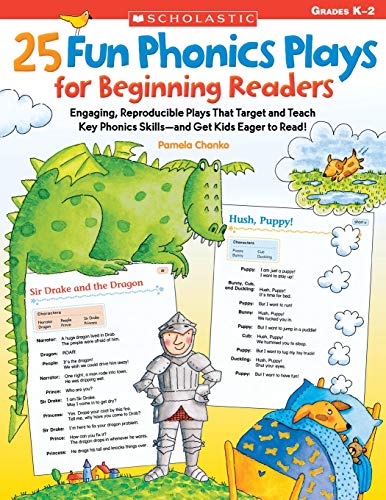It’s hard to know which is good teaching phonics through poetry book. There are alot of teaching phonics through poetry book reviews on internet. In this article we suggest top 10 the best teaching phonics through poetry book for you. Please read carefully and choose what is the best teaching phonics through poetry book for you.
Best teaching phonics through poetry book
Related posts:
Best teaching phonics through poetry book reviews
1. Daily Word Ladders: Grades 12: 150+ Reproducible Word Study Lessons That Help Kids Boost Reading, Vocabulary, Spelling and Phonics Skills!
Feature
8 3/8 x 10 7/8Description
2. 100 Write-and-Learn Sight Word Practice Pages: Engaging Reproducible Activity Pages That Help Kids Recognize, Write, and Really LEARN the Top 100 High-Frequency Words That are Key to Reading Success
Feature
8 3/4 x 10 7/8Description
3. More Phonics Through Poetry: Teaching Phonemic Awareness Using Poetry
Feature
Used Book in Good ConditionDescription
By Babs Bell Hajdusiewicz. As in Phonics Through Poetry, 112 read-aloud poemssome by well-known children's authors, others written specially for this bookimmerse children in zesty poems that focus attention on selected language sounds. A well-considered teaching apparatus accompanies each poem: word lists using the targeted sound, a "focusing talk" to cement and extend students' connection to the poem, and an idea for a hands-on activity. Photocopy masters supply "letter cards" for sounds the book targets. Multiple indexes (by poem's first line, by title, by sound, and so on) aid ease of use. Grades 23. Illustrated. 8" x 11". Good Year 1999 GDY406.4. Phonics Through Poetry: Teaching Phonemic Awareness Using Poetry
Description
By Babs Bell Hajdusiewicz. Carefully prepared lessons use the rhythm and rhyme of poetry to teach phonics. This book's 115 read-aloud poemssome from well-known children's authors like Norma Farber, Maurice Sendak, John Ciardi, and Jack Prelutsky, others written specially for this bookimmerse children in particular language sounds again and again, in word after word, within an exciting context. Each poem comes with teaching apparatus comprising word lists using the targeted sound, a "focusing talk" to cement and extend students' connection to the poem, and an idea for a hands-on activity. Photocopy masters supply "letter cards" for sounds the book targets. Multiple indexes (by the poem's first line, by title, by sound, and so on) aid ease of use. Grades preK1. Illustrated. 8" x 11". Good Year. 1999. GDY405.5. Phonics Through Poetry: Teaching Phonemic Awareness Using Poetry, PreK-1
Feature
Used Book in Good ConditionDescription
"Use the rhythm and rhyme of fun poetry to teach phonics! This collection of 115 poems is meant to be read aloud so that children hear a particular language sound again and again, in word after word, all within an exciting and meaningful context. For each "6. Phonics Poetry Pages: 50 Fill-in-the-Blank Practice Pages That Help Kids Master Essential Phonics Skills for Reading Success
Description
7. 25 Fun Phonics Plays for Beginning Readers: Engaging, Reproducible Plays That Target and Teach Key Phonics Skillsand Get Kids Eager to Read!
Description
These reproducible, read-aloud plays combine fun with phonics and fluency practice for the perfect formula to help build reading confidence. Designed to reinforce key phonics skillsincluding short vowels, long vowels, r-controlled vowels, silent e, and consonant blends and digraphsthe plays offer engaging plots that invite repeated readings and give children practice in decoding words and reading with speed, automaticity, and expression. They also boost comprehension, vocabulary, and listening skills. Great for Readers Theater! For use with Grades K2.8. Learning through Poetry: Consonant Blends and Digraphs
Feature
This must-have PreK-2 resource features consonant blends and digraphs and supports phonemic and phonologicalThe strategies provided in Learning through Poetry include phonemic matching, phonemic isolation,
Take-home activities are included to encourage linguistic interaction with friends and family members,
This book features digital resources that include activity pages, poems, family letters,
This resource supports the Common Core State Standards.
Description
This must-have resource provides 16 original poems that focus on consonant blends and digraphs to support phonemic and phonological awareness in grades PreK2. Eachgrade-level appropriate poem features a corresponding lesson that includes two cross-curricular connections and include phonemic matching, isolation, blending, substitution, and segmentation. Take-home activities encourage linguistic interaction with friends and family members, which is especially useful for English language learners. This book features digital resources that include activity pages, poems, family letters, and an audio recording of each poem. This resource is aligned to College and Career Readiness standards.About Shell Education
Rachelle Cracchiolo started the company with a friend and fellow teacher. Both were eager to share their ideas and passion for education with other classroom leaders. What began as a hobby, selling lesson plans to local stores, became a part-time job after a full day of teaching, and eventually blossomed into Teacher Created Materials. The story continued in 2004 with the launch of Shell Education and the introduction of professional resources and classroom application books designed to support Teacher Created Materials curriculum resources. Today, Teacher Created Materials and Shell Education are two of the most recognized names in educational publishing around the world.
9. Phonics Poetry: Teaching Word Families
Description
This book shows elementary teachers how and why to use phonogram poems to teach phonics. It includes many sample poems for the most common rimes in children's reading. An intro chapter shows why the onset/rime (phonogram) approach is important to teaching phonics. Chapters with original poems and other texts for the 40 or so most common rimes in children's reading are also included. Approximately 100 poems are included in this book, and there is also information on extending the use of the poems into other activities and texts. Practicing elementary teachers in grades K-3, and parents who are creating reading programs for their children at home.
10. Phonics Poetry












